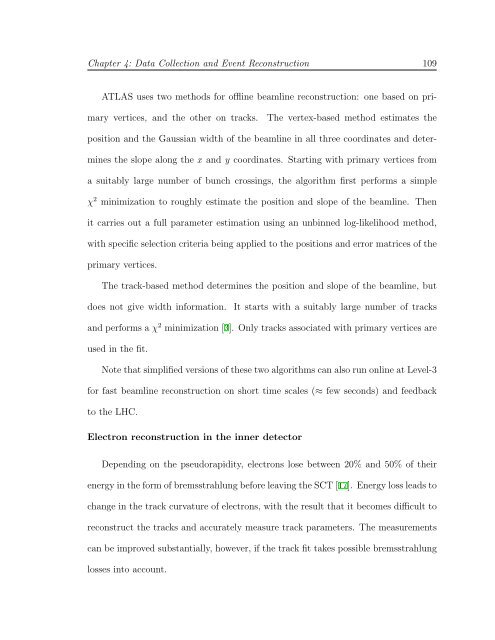Measurement of the Z boson cross-section in - Harvard University ...
Measurement of the Z boson cross-section in - Harvard University ...
Measurement of the Z boson cross-section in - Harvard University ...
You also want an ePaper? Increase the reach of your titles
YUMPU automatically turns print PDFs into web optimized ePapers that Google loves.
Chapter 4: Data Collection and Event Reconstruction 109<br />
ATLAS uses two methods for <strong>of</strong>fl<strong>in</strong>e beaml<strong>in</strong>e reconstruction: one based on pri-<br />
mary vertices, and <strong>the</strong> o<strong>the</strong>r on tracks. The vertex-based method estimates <strong>the</strong><br />
position and <strong>the</strong> Gaussian width <strong>of</strong> <strong>the</strong> beaml<strong>in</strong>e <strong>in</strong> all three coord<strong>in</strong>ates and deter-<br />
m<strong>in</strong>es <strong>the</strong> slope along <strong>the</strong> x and y coord<strong>in</strong>ates. Start<strong>in</strong>g with primary vertices from<br />
a suitably large number <strong>of</strong> bunch <strong>cross</strong><strong>in</strong>gs, <strong>the</strong> algorithm first performs a simple<br />
χ 2 m<strong>in</strong>imization to roughly estimate <strong>the</strong> position and slope <strong>of</strong> <strong>the</strong> beaml<strong>in</strong>e. Then<br />
it carries out a full parameter estimation us<strong>in</strong>g an unb<strong>in</strong>ned log-likelihood method,<br />
with specific selection criteria be<strong>in</strong>g applied to <strong>the</strong> positions and error matrices <strong>of</strong> <strong>the</strong><br />
primary vertices.<br />
The track-based method determ<strong>in</strong>es <strong>the</strong> position and slope <strong>of</strong> <strong>the</strong> beaml<strong>in</strong>e, but<br />
does not give width <strong>in</strong>formation. It starts with a suitably large number <strong>of</strong> tracks<br />
and performs a χ 2 m<strong>in</strong>imization [3]. Only tracks associated with primary vertices are<br />
used <strong>in</strong> <strong>the</strong> fit.<br />
Note that simplified versions <strong>of</strong> <strong>the</strong>se two algorithms can also run onl<strong>in</strong>e at Level-3<br />
for fast beaml<strong>in</strong>e reconstruction on short time scales (≈ few seconds) and feedback<br />
to <strong>the</strong> LHC.<br />
Electron reconstruction <strong>in</strong> <strong>the</strong> <strong>in</strong>ner detector<br />
Depend<strong>in</strong>g on <strong>the</strong> pseudorapidity, electrons lose between 20% and 50% <strong>of</strong> <strong>the</strong>ir<br />
energy <strong>in</strong> <strong>the</strong> form <strong>of</strong> bremsstrahlung before leav<strong>in</strong>g <strong>the</strong> SCT [17]. Energy loss leads to<br />
change <strong>in</strong> <strong>the</strong> track curvature <strong>of</strong> electrons, with <strong>the</strong> result that it becomes difficult to<br />
reconstruct <strong>the</strong> tracks and accurately measure track parameters. The measurements<br />
can be improved substantially, however, if <strong>the</strong> track fit takes possible bremsstrahlung<br />
losses <strong>in</strong>to account.















